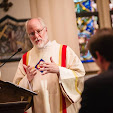San Clemente is perhaps my favorite church in Rome, in part because it is something of a metaphor for the city itself. The church, named for the fourth Pope, was built around 1100 on top of a 4th century church (also called San Clemente) that had been burned by the Normans, and then filled with dirt and rubble to form the site of the new church. That 4th century church was itself build over 1st century ruins, containing a warehouse and a house that, probably in the 2nd century, had been turned into a center for the cult of the god Mithras. It was not until the late 19th century that the Irish Dominicans who staff the church figured out that the original church must be under the one from the 1100s and began excavating.
It's all somewhat hard to picture, but its a bit like going on a trip back through time as you descend though the layers. One gets a bit of a sense of just how long Rome has been around and how its exists layer upon layer. I hope these photos will give some impression of what it's like.
 The entry to San Clemente from the street.
The entry to San Clemente from the street.Inside the atrium, which offered a respite from the busy medieval streets before entering the church.
The interior of the church built in the 1100s, now somewhat baroquified.
The spectacular apse of the upper church.
A crucifix in the upper church.
The excavation of the 4th century church (with a restored 19th century altar).
To support the church built in the 1100s, supporting walls were built around the columns in the ruins of the 4th century before it was filled in.
A fresco from the 1000s in the remains of the 4th century church, painted not too long before it was burned, depicting St. Clement.
Also in the 4th-century excavations is the grave of Leonard Boyle, OP, former prefect of the Vatican Library and, more importantly, one of the few people in the world who could read Thomas Aquinas' handwriting!
Down on the 1st century level: the altar to the god Mithras.

--Fritz










1 comment:
Fritz, Another great peice. Reminded me of Santa Cecilia, I could feel the chill all over again! I still think it was dedecated to Roberto Clemente of Pirate fame. Enjoy the remainder of your stay Love to 1 & all & all Clementes of what ever century no matter what position they played. Papa/Dad
Post a Comment